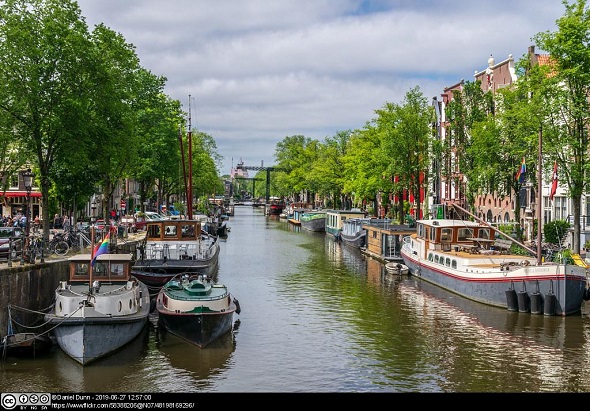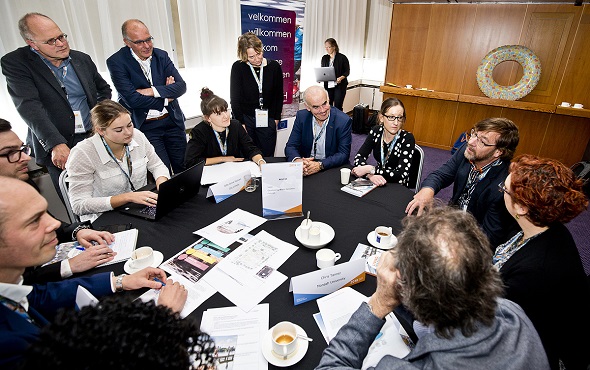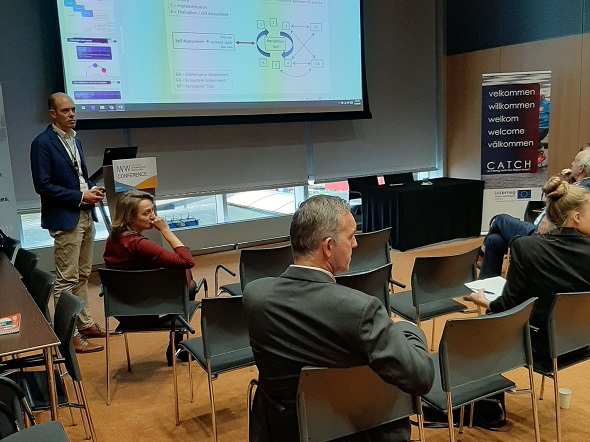
December 17, 2019, by Blue-Green team
Resilient Cities at the Amsterdam International Water Week Conference 2019
In early November the Amsterdam International Water Week (AIWW) brought together leaders from government, the private sector and academia to explore a new era of sustainable water management. AIWW is a global movement committed to a future in which a circular and sustainable water environment is achieved. One of the core topic areas this year was ‘Blue-green solutions for urban resilience’, which aligns with the research we are conducting as part of the ‘Blue-Green Futures‘ project. In this blog post, Nanco Dolman and I (Emily O’Donnell) reflect on the key themes.
Resilient Cities Leaders Forum
On 4th November we participated in the Resilient Cities Leaders Forum on the Water Sensitive Futures table. Nanco hosted the table and I was an expert contributor. We shared experiences of water sensitive urban design and Blue-Green Infrastructure (e.g. swales, rain gardens, green roofs, restored river channels) being used to manage flood risk, enhance the environment and improve quality of life. Best practice approaches in Denmark, Australia, New Zealand and the Netherlands were discussed. We also shared our ongoing research into how socio-political barriers to the implementation of Blue-Green infrastructure have been overcome in four international cities (Newcastle, UK; Ningbo, China; Rotterdam, Netherlands; and Portland, Oregon USA) – see our earlier blog for further insight.

Resilient City Leaders Forum discussions on Table 9, City of Vejle (Denmark): Developing water sensitive futures (photo credit: Guus Schoonewille).
Business as usual is not enough
The conference featured many inspiring speakers passionate about global cooperation to achieve the Sustainable Development Goals (SDGs) and to create sustainable solutions across water, waste, urban development, energy and finance. Henk Ovink, Special Envoy for International Water Affairs, delivered one of the opening keynotes that set the tone for the conference. Water is central to the climate crisis and central to the delivery of the SDGs. Business as usual is not enough, and in fact, business as usual is lethal.
There is no silver bullet to address global water challenges but collaboration with all stakeholder groups is essential, as is the combination of long-term planning and short term action. The solutions to global water challenges are not easy but the will to make the changes needed has to be present, and this is something that is lacking in many countries. What was echoed many times throughout the day was the need for action.
While it is essential to continue scientific research and keep developing innovative solutions to mitigate risk and improve peoples’ quality of life, there has to be action and a commitment to making changes, even if the economic cost is high. As echoed by David Nabarro, Former UN special adviser on the 2030 Agenda for Sustainable Development, we cannot wait for another disaster to happen.
AIWW 2019 was officially opened in a late afternoon ceremony by a video message from Ban Ki-moon, former Secretary-General of the United Nations, and leader of the Global Commission on Adaptation. He reiterated the need for action on climate change.
Day 2 – collaboration to build more resilient communities
Day 2 of the AIWW conference offered a choice of more substantive sessions, including dissemination of research, new developments and sharing practitioner experience. The key message was a need for continued collaboration to build more resilient communities.
To stimulate collaboration and accelerate dialogue between actors, a new gamified tool called STAIN was presented in the “Blue-green solutions with focus on inclusive city master planning” morning session. This digital twin city game enables the design of city resilience strategies as part of early stage multi-stakeholder analyses. It emphasises the role of local knowledge and personal interpretation of Blue-Green solutions, combining these with city data and risk data to improve the quantification of urban resilience. The city of Rotterdam, one of the Blue-Green Futures case study cities, was the first city to use STAIN to develop a Blue-Green vision for the Rotterdam-North neighbourhood.
Benchmarking cities to encourage more Blue-Green infrastructure
An afternoon workshop session was dedicated to benchmarking cities to stimulate the implementation of Blue-Green infrastructure. In the EU Interreg CATCH-project, an online decision support tool (DST) has been developed that can support cities to develop tailor-made, long term adaptation strategies. This DST builds on the ‘Water Sensitive City’ (Wong and Brown, 2008) theory that combines physical infrastructure (e.g. Blue-Green), with social systems (e.g. governance and engagement). The aim is to create cities where the infrastructure and systems enhance the connections that people have with water, and ultimately improve quality of life.

Benchmarking of cities and navigation in planning for climate adaptation” session (photo credit: Anne Fleur Weusthuis).
No comments yet, fill out a comment to be the first

Leave a Reply